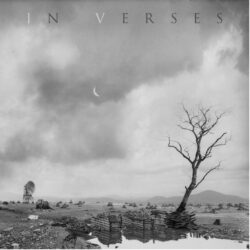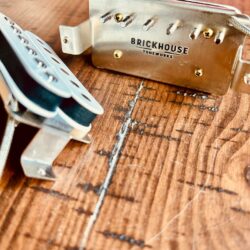
GW Editor-in-Chief Damian Fanelli’s favorite riffs (and a new way to play the Beatles’ “Something”)
In this stupendously rare video, Damian Fanelli — Guitar World magazine’s editor-in-chief since 2018 — plays and discusses some of the guitar riffs that changed his life. Get ready for…
Read more »
Karnivool announce new album ‘In Verses’
KARNIVOOL have announced a brand new album! The upcoming album, titled In Verses, is the Australian progressive rock band fourth studio record and is scheduled to be released in February…
Read more »At The Gates’ Tomas Lindberg dies age 52
We are truly saddened to report the passing of AT THE GATES vocalist Tomas Lindberg. In August, the Swedish vocalist shared via his Instagram that he was battling adenoid cystic carcinoma, a form…
Read more »The Gems release new music video for ‘Year Of The Snake’
THE GEMS have released a brand new music video! The new single, titled Year Of The Snake, is the latest track to be released by the Swedish hard rock trio…
Read more »Carach Angren release new song ‘The Resurrection of Kariba’
CARACH ANGREN have released a brand new song! The new single, titled The Resurrection of Kariba, is the latest track to be lifted from the Dutch symphonic black metal band’s…
Read more »Track Premiere: Carnage Inc – ‘Epik’
Play thrash or die with India’s Carnage Inc.
The post Track Premiere: Carnage Inc – ‘Epik’ appeared first on Decibel Magazine.

“The finish cracking here is pretty subtle and there are no faux-dings, but with use it’ll continue to age”: Fender Limited Edition Vintera II Road Worn 60s Stratocaster review
Hot on the heels of Fender’s aged Ultra Luxe Vintage models, the Road Worn returns in the Vintera II line-up
Read more »The Plot In You release new music video for ‘Silence’
THE PLOT IN YOU have released a brand new music video! The new single, titled Silence, is out now via Fearless Records and arrives alongside an official music video. The…
Read more »
Source Audio Launches theEncounter Ambient Delay+Reverb
Source Audio, a leader in next-generation guitar and bass effects pedals, proudly introduces the Encounter Ambient Delay+Reverb, a fully loaded, dual-engine effects pedal designed to unlock immersive, atmospheric soundscapes. Building upon the legacy of Source Audio’s award-winning Collider Delay+Reverb, the Encounter features dual signal processing, allowing users to combine any two of the pedal’s six delay and six reverb effects. Where the Collider focused on classic delay and reverb effects, Encounter ventures into uncharted tonal territory, delivering new, otherworldly effects for guitar, bass, synth, and adventurous sound designers of all kinds.“You asked, so we delivered!” says Roger Smith, President of Source Audio. “Ever since the release of the Collider Delay+Reverb, players have asked us to push further — into more adventurous, exploratory delay and reverb textures. Encounter answers that call. It opens up an expansive new universe of sonic possibility, combining reimagined classics with brand-new algorithms that explore both the familiar and the beautifully unknown.”At the heart of the Encounter are six delay and six reverb engines that can be used individually or combined in pairs — this includes dual delay and dual reverb setups. Users can route dual effect combinations in series, parallel, or split stereo, with independent footswitch control for each engine, effectively offering the power of two pedals in one easy-to-navigate enclosure. Stereo ins and outs, full MIDI implementation, 8 onboard preset slots (128 presets with MIDI), external expression control, and seamless integration with Source Audio’s free Neuro 3 editing software for iOS, Android, macOS, and Windows further elevate the pedal’s flexibility and creative potential.The Encounter’s effects collection features brand-new engines such as Hypersphere, a gravity-defying ambient reverb inspired by infinite spatial reflections, Kaleidoscope, a cascading, harp-like delay effect, and Shimmers, a rich, dual-pitched shimmer reverb designed for lush harmonic layering.Modernized favorites from Source Audio’s acclaimed Ventris Dual Reverb and Nemesis Delay ADT also make a return — Reverse, Lo-Fi, Trem Verb, and Swell reverbs, along with Helix, Drum Echo, Noise Tape (based on the Roland Space Echo) and Resonant delays — all reimagined with expanded parameter control.In addition, musicians can preview and explore the sounds and editing capabilities of the Encounter before purchasing the pedal, using the Neuro 3’s new SoundCheck™ feature. Neuro 3 is Source Audio’s entirely free effects editing, preset sharing, and organizing software. SoundCheck features prerecorded, unaffected guitar, bass, keyboard, and drum loops that can be played through bit-perfect replications of Source Audio One Series pedals. Users can audition presets or use the effect editor and hear changes in real-time, using only a smartphone or computer.
Read more »
Brickhouse Toneworks Introduces Mason Deluxe P.A.F. Humbuckers
Adding to the company’s lineup of premium US-made pickups, Brickhouse Toneworks has introduced the Mason Deluxe P.A.F. pickup. Available individually or in matched sets, the Mason Deluxe delivers the classic, exquisitely balanced tone of a vintage 1960s P.A.F. humbucker with added bite. They are a direct drop-in replacement for standard sized humbuckers.Sporting AlNiCo 4 magnets for enhanced attack and articulation, the Mason Deluxe P.A.F. has the clarity of a lower wind with the power of a fuller wind. Pickup master David Shepherd designed the pickup with two slightly different wire thicknesses on each coil, along with carefully calibrated asymmetrical coils, to bring out the maximum frequencies and dynamic range possible.Expanding on the legacy of Brickhouse Toneworks’ highly regarded 1960 P.A.F. and Semi 60 P.A.F. humbuckers, the Mason Deluxe P.A.F.’s deliver a unique tonal profile characterized by a chimey, bell-like clarity and exceptional articulation. The sound is both smooth and responsive, with a dynamic range that allows for a sweet, rolled-off tone as well as a powerful, aggressive distortion. A defining feature is the rich, harmonic overtones that bloom and sustain, providing a heightened sense of depth and dimensionality. The pickups also exhibit a slight microphonic effect, which enhances pick attack definition. This results in a complex, yet clear sound—fat and woody in the neck position, and sparkling with pronounced punch and tonal definition in the bridge.
The result: an extraordinarily responsive P.A.F. humbucker with a transparent and open sound, allowing the guitar and player’s natural tone to be the star of the show.Key Features of the Mason Deluxe:AlNiCo 4 Roughcast Long Bar Magnets, Unpotted CoilsVintage Correct Long Leg Frames and Butyrate Plastic BobbinsVintage Correct Alloys, Coil Wire and Braided Single Conductor LeadsVintage Correct Hand Ground, Hand Buffed P.A.F. CoversDC Resistance – Bridge: 8.1k (Average)DC Resistance – Neck: 7k (Average)Made in the USA with premium quality materialsThe Brickhouse Toneworks Mason Deluxe P.A.F. street price starts at $195 each and starts at $390 per set. Visit www.brickhousetone.com or contact info@brickhousetone.com for more information and order yours directly.
